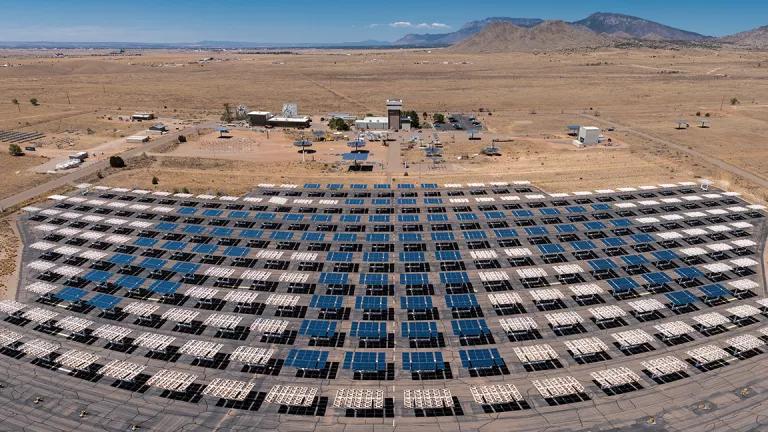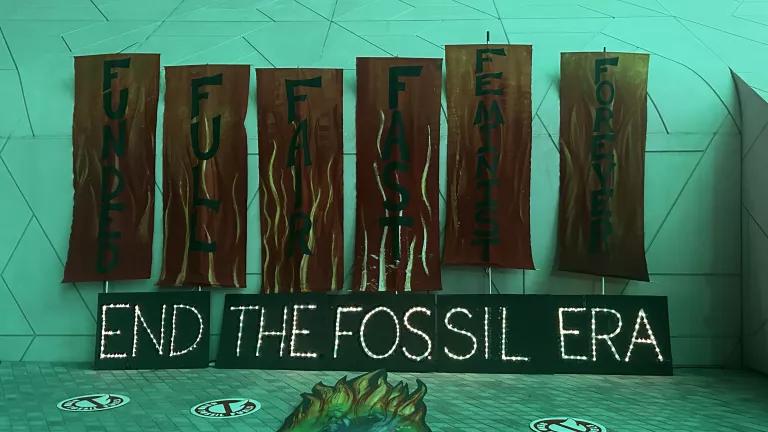Climate Change Is Burning NM. It's Time for Clean Energy.
To continue to live and sustain our homes and families, we have to work together to improve our resilience and transition to clean energy, economic development, and new investments in family sustaining jobs in clean industries.

View from the Rio Grande Gorge, near Taos, in mid May
Alana Miller
New Mexicans are facing the impacts of climate change like never before. Record breaking fires across my home state have forced thousands to evacuate, hundreds of homes are already lost; hundreds of thousands of acres burned and all of our forests are at risk and indefinitely closed. New Mexican communities that have sustained themselves for hundreds of years have faced unprecedented destruction and now encounter high rebuilding costs and an uncertain future climate. Here and here are some opportunities to pitch in to help those most impacted by the fires.
These fires are one of the expected results of decades of warming and drying of the region caused by climate change. Climate change is gaining speed and we continue to rely on fossil fuels. To sustain our homes and families as the threats of a changing climate grow ever worse, we have to work together to improve our resilience and transition to clean energy. As we rebuild, we need a new focus on clean, zero carbon economic development and new investments in family sustaining jobs in clean industries.
Clean energy incentives and investments
We need a diverse economy driven by clean energy. Thousands of households- some that will be rebuilding from the ground up- could benefit from incentives to switch to electric vehicles (EV) and making new and existing homes and buildings more efficient- and free of fossil fuels. We can meet this need through expanding our state sustainable building tax credit, increasing rebates for low income homes in particular, through adopting an EV tax credit; and through expanding low income weatherization and electrification funding through Community Energy Efficiency Development block grants and other programs.
The state also has billions of dollars in federal funds from the bipartisan infrastructure bill for transportation which will be best used to support free, zero pollution electric transit for communities across the state and expanded protected bike and pedestrian infrastructure. The state can also lead by example with capital outlay dedicated to ensuring all state and local buildings are efficient and powered with on-site renewable energy; and updating procurement requirements to make state and local vehicle fleets fully electric.
State economic development partnership
To ensure New Mexico is not only using and benefiting from clean energy, we should also invest in state partnerships and tax incentives to bring zero carbon industries to the state. Such a policy should support both those that manufacture components of the clean energy transition (electric cars, batteries, solar panels, wind turbines, etc.) and industries that can utilize New Mexico’s immense renewable energy potential. New private-public partnerships (PPPS) for zero carbon economic developments zones, Zero-carbon targeted LEDA expansions, and with state tax credits for zero carbon industries could all help support growth and leadership in these critical sectors.
New Mexico is already home to over 11,000 full time jobs in the clean energy economy. These policies and actions will drive more employment and economic opportunity in this sector.
Accelerating clean energy deployment and use
Energy efficiency and electrification can help spur economic development and diversification which is why we should accelerate the transition to 100% clean electric generation: required in the state by 2045 for most utilities, we should move faster by requiring utilities to 90% emissions reductions by 2030 and aim for 100% by 2035. Xcel energy is already aiming for 90% reductions in Colorado by 2030 and PNM and Avandgrid agreed to target for 100% clean by 2035 in their merger settlement proposal last year. We can meet- and maybe even beat- these targets.
Not only is eliminating carbon pollution from the electric sector cost effective now, but it is also the keystone of economic development and pollution reduction in other sectors. To benefit from clean electricity in our homes and vehicles in the future, we need to accelerate the rate of heat pump adoption in buildings with incentives, low-income housing weatherization, regular building code updates and a zero carbon target for all buildings by 2040.
Transportation is the largest source of carbon emissions nationwide- and second in New Mexico. We can eliminate most transportation emissions by ensuring that New Mexicans have access to the increasing numbers of clean electric cars and trucks through sales requirements: New Mexico recently adopted clean car standards through model year 2026, and will have the option of adopting stronger standards later this fall. Advanced clean truck standards for medium and heavy-duty trucks are also available for the state to adopt (other states already have!)- and clean car standards that require continued improvement through 2035 will be available later this year. Emissions will continue to decrease as additional clean electricity is added to the grid. Similarly, existing industries should be encouraged to use electricity rather than fossil fuels where feasible- we should ensure access to electricity to all potential users- and cut energy use with efficiency through industrial benchmarking requirements.
Now. Is. The. Time.
New Mexico has the technology and the resources to invest in a more resilient economy and to lead a clean energy economy that can support families in every part of the state. Clean economic development, energy efficiency, renewables and electrification are the keys to eliminating carbon pollution. If we fail to act, the consequences are dire. Together we can secure a healthy and clean economy that will sustain New Mexico for generations to come.



